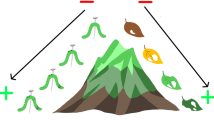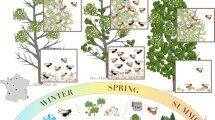Abstract
The distribution of theFrankliniella speciesF. occidentalis (Pergande) andF. intonsa (Trybom) (Thysanoptera: Thripidae), and of the predatory bugOrius niger (Wolff) (Hemiptera: Anthocoridae), in various organs of the cotton plant, as well as prey — predator interactions between thrips andO. niger, were investigated over 6 years in cotton fields in the eastern Mediterranean region of Turkey. The highest number of larvae ofFrankliniella spp. were found inhabiting bolls, whereas the adults colonized mainly flowers. The majority of predatory bug nymphs were present on leaves, followed by bolls, whereasO. niger adults visited mostly flowers. The thrips larvae were most likely preyed upon on flowers and squares, and bolls were safe plant parts for thrips, with a low predation rate. An intermediate but relatively high predation rate occurred on cotton leaves. In further field experiments, the effects of insecticide treatment on the relationships betweenO. niger andFrankliniella spp. were investigated. These trials revealed that a higher correlation existed between the numbers of adultO. niger in flowers andFrankliniella spp. in non-treated cotton fields than in insecticide-treated fields. The proportions of prey/predator in flowers ranged from 1.53 to 19.28 and were below four thrips per predator at most sampling dates in some of the non-treated cotton fields. It is concluded thatO. niger is an effective predator that can play an important role in suppressing population increase ofFrankliniella spp. in cotton.
Similar content being viewed by others
References
Atakan, E., Coll, M. and Rosen, D. (1996) Within-plant distribution of thrips and their predators: effects of cotton variety and developmental stage.Bull. Entomol. Res. 86:641–646.
Atakan, E. and Ozgur, A.F. (2000) The population fluctuations ofFrankliniella intonsa (Trybom) andFrankliniella occidentalis (Pergande) (Thysanoptera: Thripidae) in cotton production areas of Cukurova region.Proc. Fourth Turkish National Congress of Entomology (Aydın, Turkey), pp. 53–61 (Turkish, with English abstract).
Atakan, E. and Ozgur, A.F. (2001) Preliminary investigation on damage byFrankliniella intonsa (Trybom) (Thysanoptera: Thripidae) to cotton plants in Cukurova region of Turkey.Proc. Seventh Int. Symp. on Thysanoptera (Reggio Calabria, Italy), pp. 221–224.
Atakan, E. and Ozgur, A.F. (2001) Determining the favorable sampling time forFrankliniella intonsa on cotton.Proc. Seventh Int. Symp. on Thysanoptera (Reggio Calabria, Italy), pp. 225–227.
Atakan, E. and Ozgur, A.F. (2001) Investigation on relationship between the population fluctuations ofFrankliniella intonsa (Trybom),Frankliniella occidentalis (Pergande) (Thysanoptera: Thripidae) and population development of polyphagous predators in cotton fields.Turk. J. Entomol. 25:267–273 (Turkish, with English abstract).
Atakan, E., Ozgur, A.F. and Kersting, U. (1998)Frankliniella occidentalis (Thysanoptera: Thripidae) on cotton in Çukurova Region.Proc. Sixth Int. Symp. on Thysanoptera (Antalya, Turkey), pp. 7–12.
Brødsgaard, H.F. (1994) Insecticide resistance in European and African strains of western flower thrips (Thysanoptera: Thripidae) tested in a new residue-on-glass test.J. Econ. Entomol. 87:141–146.
Butt, T.M. and Brownbridge, M. (1997) Fungal pathogens of thrips.in: Lewis, T. [Ed.] Thrips as Crop Pests. CABI, Wallingford, UK. pp. 399–433.
Deligeorgidis, P.N. (2002) Predatory effect ofOrius niger (Wolff) (Hem., Anthocoridae) onFrankliniella occidentalis (Pergande) andThrips tabaci Lindeman (Thysan., Thripidae).J. Appl. Entomol. 126:82–85.
Deligeorgidis, P.N., Athanassiou, C.G. and Kavallieratus, N.G. (2002) Seasonal abundance, spatial distribution and sampling indices of thrips populations on cotton: a 4-year survey from central Greece.J. Appl. Entomol. 126:343–348.
Dick, F.F. and Jarvis, J. (1962) The habits and abundance ofOrius insidiosus (Say) on corn.J. Econ. Entomol. 63:814–817.
Dintenfass, L.P., Bartell, D.P. and Scott, M.A. (1987) Predicting resurgence of western flower thrips (Thysanoptera, Thripidae) on onions after insecticide application in the Texas high plains.J. Econ. Entomol. 2:502–506.
Ehler, L.F., Eveleens, K.G. and Van den Bosch, R. (1973) An evaluation of some natural enemies of cabbage looper in California.Environ. Entomol. 84:1009–1015.
Funderburk, J., Stavisky, J., and Olson, S. (2000) Predation ofFrankliniella occidentalis (Thysanoptera: Thripidae) in field peppers byOrius insidiosus (Hemiptera: Anthocoridae).Environ. Entomol. 29:376–382.
Gonzales, D., Patterson, B.R., Leigh, T.F. and Wilson, L.T. (1982) Mites: a primary food source for two predators in San Joaquin Valley.Calif. Agric. 36:18–20.
Gonzales, D., Ramsey, D.A., Leigh, T.F., Ekbom, B.S. and van den Bosch, R. (1977) A comparison of vacuum and whole-plant methods for sampling predaceous arthropods on cotton.Environ. Entomol. 6:750–760.
Gonzales, D., and Wilson, L.T. (1982) A food-web approach to economic threshold: a sequence of pest/predaceous arthropods of California cotton.Entomophaga 27:31–43.
Hardin, R.H., Benrey, B., Coll, M., Lamp, W.O., Roderich, G.K. and Barbosa, P. (1995) Arthropod pest resurgence: an overview of potential mechanism.Crop Prot. 14:3–18.
Immaraju, J.A., Paine, T.D., Bethke, J.A., Robb, K.L. and Newman, J.P. (1992) Western flower thrips (Thysanoptera: Thripidae) resistance to insecticides in coastal California greenhouses.J. Econ. Entomol. 85:9–14.
Jacobson, R.J. (1997) Integrated pest management (IPM) in glasshouses.in: Lewis, T. [Ed.] Thrips as Crop Pests. CABI, Wallingford, UK. pp. 639–666.
Jones, S.A. and Morse, J.G. (1995) Use of isoelectric focusing electrophoresis to evaluate citrus thrips (Thysanoptera: Thripidae) predation byEuseius tularensis (Acari: Phytoseiidae).Environ. Entomol. 24:1040–1051.
Kiman, Z.B. and Yeargan, K.V. (1985) Development and reproduction of the predatorOrius insidiosus (Hemiptera: Anthocoridae) reared on diets of selected plant material and arthropod prey.Ann. Entomol. Soc. Am. 78:464–467.
Klein, M. and Ben-Dov, Y. (1991) The western flower thripsFrankliniella occidentalis, a potential cotton pest in Israel.Hassadeh 72:178–180 (Hebrew, with English abstract).
Lo, Z.Y., Chang, W.N. and Zhou, C.M. (1983) Population dynamics of flower bugs in cotton fields and the effect of insecticidal application on them.Rev. Appl. Entomol. (1994) 71(2):1365 (abstr.).
Loomans, A.J.M., Murai, T. and Greene, I.D. (1997) Interactions with hymenopterous parasitoids and parasitic nematodes.in: Lewis, T. [Ed.] Thrips as Crop Pests. CABI, Wallingford, UK. pp. 215–258.
Nagai, K. (1990) Suppressive effect ofOrius sp. (Hemiptera: Anthocoridae) on the population density ofThrips palmi Karny (Thysanoptera: Thripidae) in aubergine in an open field.Jpn. J. Appl. Entomol. Zool. 34:109–114.
Pickett, C.H., Wilson, L.T. and Gonzales, D. (1988) Population dynamics and within-plant distribution of the western flower thrips (Thysanoptera: Thripidae), an early-season predator of spider mites infesting cotton.Environ. Entomol. 17:551–559.
Reed, J.T. and Reinecke, J. (1990) Western flower thrips on cotton: plant damage and mite predation — preliminary observations.Proc. Beltwide Cotton Prod. Res. Conf. (Las Vegas, NV, USA), pp. 309–310.
Ripper, W.E. (1956) Effect of pesticides on balance of arthropod populations.Annu. Rev. Entomol. 1:402–433.
Rummel, D.R. and Quisenberry, J.E. (1979) Influence of thrips injury on leaf development and yield of various cotton genotypes.J. Econ. Entomol. 72:706–709.
Sabelis, M.W. and Van Rijn, P.C.J. (1997) Predation by insects and mites.in: Lewis, T. [Ed.] Thrips as Crop Pests. CABI, Wallingford, UK. pp. 259–354.
Salas-Aquliar, J. and Ehler, L.E. (1977) Feeding habits ofOrius tristicolor.Ann. Entomol. Soc. Am. 70:60–62.
SPPS (1999) SYSTAT Statistics II. SPPS Inc., Chicago, IL, USA.
Stoltz, R.L. and Stern, V.M. (1978) The longevity and fecundity ofOrius tristicolor when introduced to increasing numbers of the preyFrankliniella occidentalis.Environ. Entomol. 7:197–198.
Tanagoshi, L.K. (1991) Biological control of citrus thrips,Scirtothrips citri by predaceous phytoseiid mites.in: Parker, B.L., Skinner, M. and Lewis, T. [Eds.] Towards Understanding Thysanoptera.U.S. For. Serv. Gen. Tech. Rep. NE-147. pp. 399–418.
Tavella, L., Arzone, A. and Alma, A. (1991) Researches onOrius laevigatus (Fieb.), a predator ofFrankliniella occidentalis (Perg.) in greenhouse. A preliminary note.IOBC/WPRS Bull. 14:65–72.
Terry, L.I. (1997) Host selection, communication and reproductive behavior.in: Lewis, T. [Ed.] Thrips as Crop Pests. CABI, Wallingford, UK. pp. 65–118.
Terry, L.I. and Barstow, B.B. (1988) Susceptibilitiy of early season cotton floral bud types to thrips (Thysanoptera: Thripidae) damage.J. Econ. Entomol. 81:1785–1791.
Trichilo, P.J., and Leigh, T.F. (1986) Predation on spider mite eggs by the western flower thrips,Frankliniella occidentalis (Thysanoptera: Thripidae), an opportunist in a cotton agroecosystem.Environ. Entomol. 15:821–825.
van den Meiracker, R.A.F. and Ramakers, P.M.J. (1991) Biological control of the western flower thrips,Frankliniella occidentalis on sweet pepper with the anthocorid predatorOrius insidiosus.Meded. Fac. Landbouwwet. Rijks Univ. Gent 56:241–249.
van de Veire, M. and Degheele, D. (1992) Biological control of the western flower thrips,Frankliniella occidentalis (Pergande) (Thysanoptera: Thripidae), glasshouse sweet peppers withOrius spp. (Hemiptera: Anthocoridae). A comparative study betweenO. niger (Wolff) andO. insidiosus (Say).Biocontrol Sci. Technol. 2:281–283.
Wilson, L.T. and Gutierrez, A.P. (1979) Within-plant distribution of predators on cotton: comments on sampling and predator efficiencies.Hilgardia 48:3–11.
Wilson, L.T., Trichilo, P.J. and Gonzales, D. (1991) Natural enemies of spider mites (Acari: Tetranychidae) on cotton in Australia.Bull. Entomol. Res. 86:297–305.
Author information
Authors and Affiliations
Corresponding author
Additional information
http://www.phytoparasitica.org posting May 12, 2006.
Rights and permissions
About this article
Cite this article
Atakan, E. Associations betweenFrankliniella spp. andOrius niger populations in cotton. Phytoparasitica 34, 221–234 (2006). https://doi.org/10.1007/BF02980949
Received:
Accepted:
Issue Date:
DOI: https://doi.org/10.1007/BF02980949




